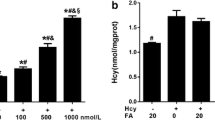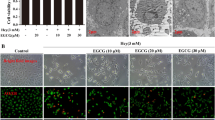Abstract
Hyperhomocysteinemia is an independent risk factor for the development of atherosclerosis. However the underlying mechanisms responsible for endothelial cell injury with increased plasma concentration of homocysteine or homocysteine derivatives remains still incompletely elucidated. In this study, we investigated the ability of homocysteine (Hcy) and homocysteine thiolactone (HcyT) to induce cell death and IL-8 secretion in primary human umbilical vein endothelial cells (HUVEC). Hcy and HcyT were both cytotoxic and capable of promoting cell death, as measured by caspase-3 activation and DNA fragmentation. ELISA assays clearly demonstrated that Hcy and HcyT strongly activated IL-8 release. Furthermore, our results showed that HcyT was much more efficient than Hcy in activating caspase-3 or in inducing IL-8 secretion. The use of antioxidants such as vitamin C and vitamin E strongly but not completely reduced programmed cell death and chemokine release suggesting that other pathways different than reactive oxygen species are also involved. This study suggests that Homocysteine derivatives like HcyT might possess stronger cytotoxicity and pro-inflammatory properties and that Hcy derivatives levels should therefore be more taken into account during diagnostics.
Similar content being viewed by others
Abbreviations
- Hcy:
-
homocysteine
- HcyT:
-
homocysteine thiolactone
- HUVEC:
-
human umbilical vein endothelial cells
References
Wilcken DEL, Dudman NPB: Homocystinuria and atherosclerosis In: AJ Lusis, JI Rotter, RS Sparkes (eds). Molecular Genetics of Coronary Artery Disease; Candidate Genes and Process in Atherosclerosis. Monograms in Human Genetics, Karger, New York, NY, 1992
Mudd SH, Havlik R, Levy HL, McKusicK VA, Feinleib M: Cardiovascular risk in Heterozygotes for homocystinuria. Am J Hum Genet 34: 1018–1021, 1982
Frosst P, Blom HJ, Milos R, Goyette P, Sheppard CA, Matthews RJ, Boers GJ, den Heijer M, Kluijtmans LA, van den Heuvel LP, Rozen R: A candidate genetic risk factor for vascular disease: a common mutation in methylenetetrahydrofolate reductase: isolation of cDNA, mapping and mutation identification. Nat Genet 7: 195–200, 1995
Selhub J, Jacques PF, Wilson PWF, Rush D, Rosenberg IH: Vitamin status and intake as primary determinants of homocysteinemia in an elderly population. J Am Med Assoc 270: 2693–2698, 2001
Skurk S, Walsh K: A new mechanism of Homocysteine-Mediated Endothelial Cell Cytotoxicity. Hypertension 43: 1168–1170, 2004
Clarke R, Daly L, Robinson K, Naughten E, Cahalane S, Fowler B and Graham I: Hyperhomocysteinemia: an independent risk factor for vascular disease. N Engl J Med 324: 1149–1155, 1991
Audelin MC, Genest J Jr: Homocysteine and cardiovascular disease in diabetes mellitus. Atherosclerosis 159: 497–511, 2001
Herrmann W, Knapp JP: Hyperhomocysteinemia: a new risk factor for degenerative diseases. Clin Lab 48: 471–481, 2002
Polidori MC, Marvardi M, Cheribini A, Senin U, Mecocci P: Heart disease and cardiovascular risk factors in the cognitively impaired elderly: implication for Alzheimer's dementia. Aging 13: 231–239, 2001
Schroecksnadel K, Frick B, Wirleitner B, Winkler C, Schennach H, Fuchs D: Moderate Hyperhomocysteinemia and immune activation. Curr Pharm Biotechnol 5: 107–118, 2004
Den Heijer M, Koster T, Blom HJ, Bos GM, Breit E, Reitsma PH, et al.: Hyperhomocysteinemia as a risk factor for deep-vein thrombosis. N Engl J Med 344: 759–762, 1996
McCully KS: Homocysteine and vascular disease. Nat Med 2: 386–389, 1996
Lawrence de Koning AB Werstuck GH, Zhou J, Austin RC: Hyperhomocysteinemia and its role in the development of atherosclerosis. Clin Biochem 36: 431–441, 2003
Bessede G, Miguet C, Gambert P, Neel D, Lizard G: Efficiency of Homocysteine plus Copper in inducing apoptosis is inversely proportional to γ glutamyl transpeptidase activity. FASEB J 15: 1927–1940, 2001
Di Simone N, Maggiano N, Caliandro D, Riccardi P, Evangelista A, Carducci B, Caruso A: Homocysteine induces trophoblasts cell death with apoptotic features. Biol Reprod 69: 1129–1134, 2003
Poddar R, Sivasubramania N, Dibello PM, Robinson K, Jacobsen D: Homocysteine induces expression and secretion of monocyte chemoattractant protein-1 and interleukine-8 in human aortic endothelial cells: implications for vascular disease. Circulation 103: 2717–2723, 2001
Jakubowski H: Molecular basis of homocysteine toxicity in humans. Cell Mol Life Sci 61: 470–487, 2004
McCully KS: Chemical pathology of homocysteine. II. Carcinogenesis and homocysteine thiolactone metabolism. Ann Clin Labo Sci 24: 27–59, 1994
Huang RF, Huang SM, Lin BS, Wei JS, and Liu TZ: Homocysteine thiolactone induces apoptotic DNA damage mediated by increased intracellular hydrogen peroxide and caspase-3 activation in HL-60 cells. Life Sci 68: 2799–2811, 2001
Mercie P, Garnier O, Lascoste L, Renard M, Closse C, Durrieu F, et al.: Homocysteine thiolactone induces caspase-independent vascular endothelial cell death apoptosic features. Apoptosis 5: 403–411, 2000
Renvoize C, Biola A, Pallardy M, Breard J: Apoptosis: identification of dying cells. Cell Biol toxicol 14: 111–120, 1998
Loscalzo J: The oxidant stress of hyperhomocysteinemia. J Clin Invest 98: 5–7, 1996
Lang D, Kredan MB, Moat SJ, Hussain SA, Powell CA, Bellamy MF, Powers HJ, Lewis MJ: Homocysteine-induced inhibition of endothelium relaxation in rabbit aorta: role for superoxide anions. Arterioscler Thromb Vasc Biol 20: 422–427, 2000
Hermann C, Zeiher AM, Dmmeler S: Shear stress inhibits H2O2-induced apoptosis in human endothelial cells by modulation of the glutathione redox cycle and nitric oxide synthase. Arterioscler Thromb Vasc Biol 17: 3588–3592, 1997
Dipietrantonio AM, Hsieh TC, Wu JM: Activation of caspase-3 in HL-60 cells exposed to hydrogen peroxide. Biochem Biophys Res Commun 255: 477–482, 1999
Barroso MP, Diaz CG, Lluch GL, Malagon MM, Crane FL, Navas P: Ascorbate and alpha-tocopherol prevent apoptosis induced by serum removal independent of Bcl-2. Arch. Biochem Biophys 343: 243–248, 1997
Haendeler J, Zeiher AM, Dimmeter S: Vitamin C and Vitamin E prevent lipopolysaccharide-induced apoptosis in humans endothelial cells by modulation of Bcl-2 and Bax. Eur J Pharmacol 317: 407–411, 1996
Wu J, Karlsson K, Danielsson A: Effects of vitamins E, C and catalase on bromobenzene- and hydrogen peroxide-induced intracellular oxidation and DNA single-strand breakage in HepG2 cells. J Hepatol 26: 669–677, 1997
Upchurch GR, Welch GN, Fabian AJ, Freedman JE, Jhonson JL, Keaney JF, Loscalzo J: Homocysteine decrease bioavailable nitric oxide by a mechanism involving glutathione peroxidase. J Biol Chem 272: 17012–1701, 1997
Heinecke JW, Rosen H, Suzuki LA, Chait A: The role of sulfur containing amino acids in superoxide production and modification of low density lipoprotein arterial smooth muscle cell. J Biol Chem 262: 10098–10103, 1987
Outinen PA, Sood SK, Pfeifer SI, Pamidi S, Podor TJ, Li J, Weitz JL, Austin RC: Homocysteine induced endoplasmic reticulum stress and growth arrest leads to specific changes in gene expression in human vascular endothelial cell. Blood 94: 959–967, 1999
Outinen PA, Sood SK, Liaw PC, Sarge KD, Maeda N, Hirsh J, Podor TJ, Weitz JL, Austin RC: Characterization of the stress inducing effects of homocysteine. Biochem J 332: 213–221, 1998
Ron D: Hyperhomocysteinemia and function of the endoplasmic reticulum. J Clin Invest 107: 1221–1222, 2001
Kokame K, Kato H, Miyata T: Homocysteine-respondent genes in vascular endothelial cells identified by differential display analysis. GRP78//BIP and novel genes. J Biol Chem 271: 29659–29665, 1996
Cai Y, Zhang C, Nawa T, Aso T, Tanaka M, Oshiro S, Ichijo H, Kitajima S: Homocysteine responsive ATF3 gene expression in human vascular endothelial cells: Activation of c-jun NH(2) terminal Kinase and promoter responsive element. Blood 96: 2140–2148, 2000
Zhang C, Cai Y, Adachi MT, Oshiro S, Aso T, Kaufman RJ, Kitajima S: Homocysteine induces programmed cell death in human vascular endothelial cells through activation of the unfolded protein response. J Biol Chem 276: 35867–35874, 2001
Hultberg B, Andersson A, Isaksson A: Metabolism of homocysteine, its relation to the other cellular thiols and its mechanism of cell damage in a cell culture line (human histiocytic cell line U937). Biochim Biophys Acta 1269: 6–12, 1995
Huang RF, Huang SM, Lin BS, Hung CW, Lu HT: N-Acetylcystein, Vitamin C and vitamin E diminish homocysteine thiolactone induced apoptosis in human promyeloid HL-60 cells. J Nutr 132: 2151–2156, 2002
Jaffe EA, Nachmann RL, Becker CG, Minick CR: Culture of human endothelial cells derived from unbilical veins: Identification by morphologic and immunologic criteria. J Clin Invest 52: 2745, 1973
Denizot F, Lang R: Rapid colorimetric assay for cell growth and survival: Modifications to the tetrazolium dye procedure giving improved sensitivity and reliability. J Immunol Methods 89: 271–277, 1986
Slater TF, Sawyer B, Strauli U: Studies on succinate-tetrazolium reductase systems. III. Points of coupling of four different tetrazolium salts. Biochem Biophys Acta 77: 383–393, 1963
Foster V: Mechanisms leading to myocardial infarction: insight from studies of vascular biology. Circulation 90: 2126–2146, 1994
Harker LA, Ross R, Slichter SJ, Scott CR: Homocysteine induced atherosclerosis: The role of endothelial cell injury and platelet response in its genesis. J Clin Invest 58: 731–741, 1976
Ross R: Atherosclerosis-an inflammatory disease. N Engl J Med 340: 115–126, 1999
McCully KS: Homocysteine and vascular disease. Nat Med 2: 386–389, 1996
Eberhardt RT, Forgione MA, Cao A, Leopold JA, Rudd MA, Trolliet M, Heydrick S, Stark R, Klings ES, Moldovan NI, Yaghoubi M, Glodshmidt-Clermont PJ, Farber HW, Cohen R, Loscalzo J: Endothelial dysfunction in a murine model of mild hyperhomocysteinemia. J Clin Invest 106: 483–491, 2000
Tsai JC, Perella MA, Yoshizumi M, Hsiech CM, Haber E, Shlegel R, Lee ME: Promotion of vascular smooth muscle cell growth by homocysteine: a link to atherosclerosis. Proc Natl Acad Sci USA 91: 6369–6373, 1994
Stamler JS, Osborne JA, Jaraki O, Rabbani LE, Mullins M, Singel D: Adverse vascular effects of homocysteine are modulated by endothelium-derived relaxing factors and related oxides of nitrogen. J Clin Invest 91: 308–318, 1993
Stamler JS, Loscalzo J: Endothelium derived relaxing factor modulates the atherothrombogenic effects of homocysteine. J Cardiovasc Pharmacol 20: 202–204, 1992
Grow AJ, Cobb F, and Stamler JS: Homocysteine, nitric oxide and nitrosothiols. In: Homocysteine in health and disease, D Jacobsen, R Carmel (eds). Cambridge University Press, Cambridge, 2001 pp. 39–45
Jakubowski H: Calcium-dependent human serum homocysteine thiolactone hydrolase: A protective mechanism against protein N homocysteinylation. J Biol Chem 275: 3957–3962, 2000
Suhara T, Fukuo K, Yasuda O, Tsubakimoto M, Takemura Y, Kawamoto H, et al.: Homocysteine enhances endothelial apoptosis via upregulation of Fas mediated pathways. Hypertention 43: 1208–1213, 2004
Jakubowski H: Metabolism of homocysteine thiolactone in human cell culture. J Biol Chem 272: 1935–1942, 1997
Jakubowski H: Protein homocysteinylation possible mechanism underlying pathological consequences of elevated homocysteine levels. FASEB J 13: 2277–2283, 1999
Jakubowski H, Zhang L, Bardeguez A, Aviv A: Homocysteine-thiolactone and protein homocysteinylation in human endothelial cells: implications for atherosclerosis. Cir Res 87: 45–51, 2000
Wang G, Siow YL, O K: Homocysteine induces monocyte chemoattractant protein-1 expression by activation NF-kappa B in THP-1 macrophages. Am J Physiol Heart Circ Physiol 280: 2840–2847, 2001
Wang G, O K: Homocysteine stimulates the expression of monocyte chemoattractant protein-1 receptor (CCR2) in human monocytes: Possible involvement of oxygen free radicals. Biochem J 357: 233–240, 2001
Collins T, Cybulsky MI: NF-kappaB: pivotal mediator or innocent bystander in atherogenesis? J Clin Invest 107: 255–264, 2001
Au-Yeung KKW, Woo CWH, Sung FL, Yip JCW, Siow YL, Karmin O: Hyperhomocysteinemia activates Nuclear Factor-kB in endothelial cells via oxidative stress. Cir Res 94: 28–36, 2004
Author information
Authors and Affiliations
Corresponding author
Rights and permissions
About this article
Cite this article
Kerkeni, M., Tnani, M., Chuniaud, L. et al. Comparative Study on in Vitro Effects of Homocysteine Thiolactone and Homocysteine on HUVEC Cells: Evidence for a Stronger Proapoptotic and Proinflammative Homocysteine Thiolactone. Mol Cell Biochem 291, 119–126 (2006). https://doi.org/10.1007/s11010-006-9204-9
Received:
Accepted:
Published:
Issue Date:
DOI: https://doi.org/10.1007/s11010-006-9204-9




